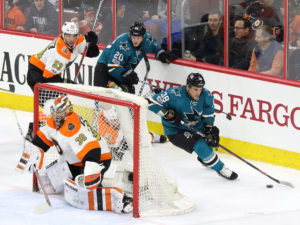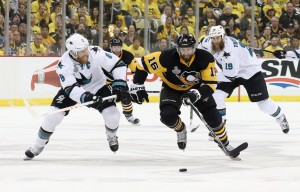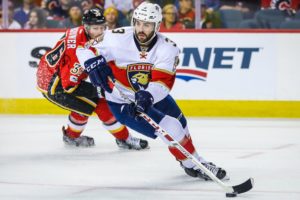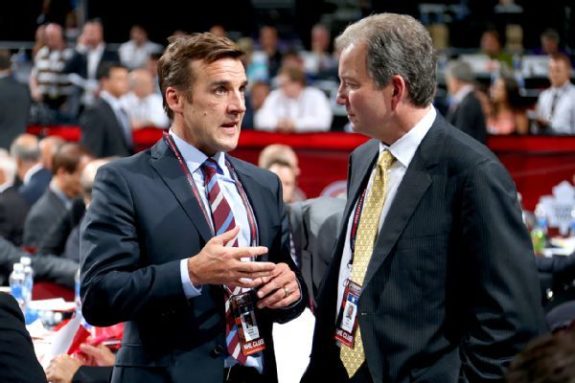The Vegas Golden Knights and the expansion draft stifled the 2017 trade deadline. Subsequently, a number of trades can be expected before the 2017 Expansion Draft. Many teams took the Golden Knights into consideration when conducting trades up until the trade deadline, with many acquiring players who are pending unrestricted free agents to avoid adding another player that would require expansion protection.
Since many general managers acted cautiously at the deadline, they may not have adequately prepared their teams for the expansion draft. Some teams are left with too many valuable players that cannot all be protected, while others do not meet the exposure requirements.
(1/4) An important reminder: Some teams might make a trade today simply to acquire a player who meets the min exposure reqs for Expansion.
— CapFriendly (@CapFriendly) March 1, 2017
Requirements for the 2017 Expansion Draft
All 30 NHL clubs must meet the exposure requirements for the expansion draft. At least one defenseman and two forwards that are under contract for the 2017-18 season must be exposed to the Golden Knights. According to the NHL’s expansion draft requirements, those forwards and defensemen must have “played in 40 or more NHL games the prior season OR played in 70 or more NHL games in the prior two seasons.”
At least one goaltender that meets the parameters outlined by the NHL must be exposed by every club as well. Those goaltenders must either be under contract or restricted free agents (RFA) “at the expiration of his current contract immediately prior to 2017-18.”
Teams have the option of protecting either seven forwards, three defensemen and one goaltender (7F/3D/1G), or eight skaters and one goaltender (8FD/1G). Players with effective no-movement clauses (NMC) must be protected unless that player chooses to waive their NMC. All first and second-year professionals and unsigned draft choices are exempt from the draft.
For those asking: if a player waives his NMC to be exposed for the expansion draft, that does NOT void his clause for trades/stuff later on.
— HockeyStatMiner (@HockeyStatMiner) February 13, 2017
2017 Trade Deadline
For many teams, the Golden Knights were in mind when coordinating transactions. Some teams took the opportunity to re-sign players for expansion draft eligibility purposes at the trade deadline.

The Philadelphia Flyers, for example, re-signed goaltender Michael Neuvirth for two years at a cap hit of $2.5 million. Neuvirth was a pending unrestricted free agent (UFA), which meant he could not be protected nor exposed. With the Flyers intending to protect goaltender Anthony Stolarz, they needed at least one goaltender that would meet the exposure requirements; re-signing Neuvirth fulfills that.
The Chicago Blackhawks acted similarly to the Flyers in re-signing both defenseman Michal Rozsival and forward Jordin Tootoo. Extending both of these players’ contracts helped the Blackhawks meet the exposure requirements. By extending Tootoo, the Blackhawks can protect Ryan Hartman, who otherwise would have been exposed in order to satisfy the requirement.
With Tootoo and Rozsival extended for one year, both players will now meet the minimum exposure requirements for the #Blackhawks pic.twitter.com/Ijw9N9Ih4F
— CapFriendly (@CapFriendly) February 28, 2017
Teams conducted trades to ensure a return on a player that could be drafted by the Golden Knights. The Edmonton Oilers, for example, likely would have exposed defenseman Brandon Davidson. Rather than risking Davidson at the expansion draft and not receiving a return on a player the Oilers’ viewed as valuable, they traded him for pending UFA David Desharnais, who fills the short-term needs of the team.

Other teams looked to acquire players that would meet the exposure regulations, giving them the flexibility to protect their own players. The Toronto Maple Leafs traded defenseman Frank Corrado to the Pittsburgh Penguins in exchange for forward Eric Fehr, defenseman Steve Oleksy, and a 2017 fourth-round pick. Fehr fulfills the exposure requisites and allows the Maple Leafs to instead protect core players like Tyler Bozak and Nazem Kadri.
The Tampa Bay Lightning traded Valtteri Filppula, who had a NMC, to the Flyers. By trading Filppula, who had a modified no-trade clause (NTC), the Lightning created an opening to protect another forward instead, which was important to them since they have a plethora of young talent with potential.
Lightning resolved lots of issues. Now more space under the cap and they won't have to protect Filppula at the expansion draft.
— Renaud Lavoie (@renlavoietva) March 1, 2017
Meeting Exposure Requirements
Many teams will have to make changes to their roster in order to meet the exposure requirements; therefore a number of transactions can be expected prior to the expansion draft.

The New York Rangers for example, currently are not projected to meet the forward requirements. The Rangers will likely protect Rick Nash (NMC), Derek Stepan, Chris Kreider, Mats Zuccarello, Kevin Hayes and J.T. Miller. The last protected spot will presumably be reserved for either Mika Zibanejad, Jesper Fast, or Oscar Lindberg. Michael Grabner will likely be exposed in the draft. Other than Grabner though, the Rangers do not have another eligible forward. The Rangers will either have to extend the contract of one of their pending free agents (RFAs Brandon Pirri, Matt Puempel—if he plays five more games—Fast, Lindberg or Zibanejad, or UFA Tanner Glass), or acquire an eligible forward before the draft.
The Arizona Coyotes, Dallas Stars, New Jersey Devils, Ottawa Senators, Toronto Maple Leafs and Vancouver Canucks, as it stands, are all in need of another eligible forward like the Rangers and will also either have to acquire a player or extend a pending free agent.
The Carolina Hurricanes have limited defensive options for the Golden Knights. Both Noah Hanifin and Jaccob Slavin are exempt, Ryan Murphy has not yet hit the minimum game requirement (and will likely be protected), Justin Faulk will almost certainly be protected, and the rest of the Hurricanes’ defensemen are pending RFAs and UFAs. If Faulk, Murphy, and Klas Dahlbeck are protected, then the options are limited to RFA Trevor Carrick or UFAs Matt Tennyson, Dennis Robertson, and Philip Samuelsson. However, Carrick, Robertson, and Samuelsson cannot hit the minimum threshold this season—only Tennyson can. The Hurricanes will either have to extend Tennyson and expose him, or acquire another defenseman.

If the Florida Panthers protect Keith Yandle (NMC), Jason Demers and Aaron Ekblad, then they will be in a similar situation as the Hurricanes. Their remaining defensemen are either exempt or free agents. The Panthers have more latitude since Jakub Kindl, Mark Pysyk, and Alex Petrovic all could be qualified with contract extensions.
The Calgary Flames will only meet the goaltending parameters if Tom McCollum is the exposed goaltender, since both Brian Elliot and Chad Johnson are pending UFAs. On the other hand, if McCollum is the goaltender the Flames protect, then either Elliot or Johnson would have to be re-signed through the next season in the same way the Flyers extended Neuvirth.
Trading Before the Expansion Draft
Many teams did not accomplish all of their trades at the deadline. Instead, they are essentially using their own players as playoff rentals. With the expansion draft looming, teams may look to trade valuable players that otherwise would be drafted if not protected.
The Anaheim Ducks have an abundance of defensemen and cannot protect them all. If the Ducks choose to protect four defensemen, not only would valuable defensemen still be left exposed, but it would limit the number of forwards they could protect.

Ducks defenseman Kevin Bieksa has a NMC, but could be asked to waive it so the team can protect their other defensive assets. That leaves the Ducks with Hampus Lindholm, Sami Vatanen, Cam Fowler and Josh Manson to fit either three or four spots. Fowler is set to become a UFA in 2018, so the Ducks have to establish whether or not he will be a long-term fixture with the team—if not, they could look to trade him before the draft.
However, if Fowler does want to re-sign with the Ducks, general manager Bob Murray may instead look to trade Vatanen or Manson. Vatanen carries a high cap hit of $4.875 million until 2020 and extending Fowler will be costly, so Vatanen could be the player moved to relieve the Ducks of high defensive salaries. The Ducks have talented, young defensemen, like Shea Theodore, who are exempt from the draft, giving them the flexibility to lose a defenseman like Vatanen.
By trading a defenseman that would likely be drafted if not protected and having Bieska waive his NMC, the Ducks would be able to protect 7F/3D/1G, giving them the ability to protect forwards like Jakob Silfverberg, who likely would be exposed if the Ducks protected 8FD/1G.

The New York Islanders also looked to move a goaltender at the deadline in Jaroslav Halak. The Islanders could still look to trade him before the draft to secure a return for their player. If the Islanders are able to move Halak, they still will meet the exposure requirements with both Jean-Francios Berube and Christopher Gibson.
Since the Pittsburgh Penguins decided to retain goaltender Marc-Andre Fleury at the deadline instead of trading him, the Penguins will presumably look to trade him before the expansion draft. The Penguins have already determined that they will protect Matt Murray instead of Fleury, so they certainly have to move Fleury or risk losing him for nothing in the draft.
If the Penguins successfully move Fleury, they will not meet the exposure requirements for goaltending. They will either have to acquire a pending RFA goaltender or one that is under contract for the 2017-18 season to meet the requirements.

The Vegas Golden Knights influenced the 2017 trade deadline and forced teams to act cautiously and meticulously. Many teams still have to make a number of transactions to prepare themselves for the expansion draft. For the teams that conducted trades at the deadline, they have to decide whether to retain the player they acquired or maintain their original roster.
Nevertheless, the Golden Knights can anticipate trades before the draft, but may not anticipate exactly who will be traded—complicating their roster projections. Even gauging which UFAs will be available by the draft will be a challenge for the Golden Knights, because teams without intentions of re-signing their UFAs may look to trade them for draft picks.
As much as general manager George McPhee and the Golden Knights can speculate as to which players will be protected and exposed, for many teams their choices of protected players are still fluid. For now, the Golden Knights may not be able to anticipate the exact exposure list, but can at least predict a number of trades to happen before the expansion draft.